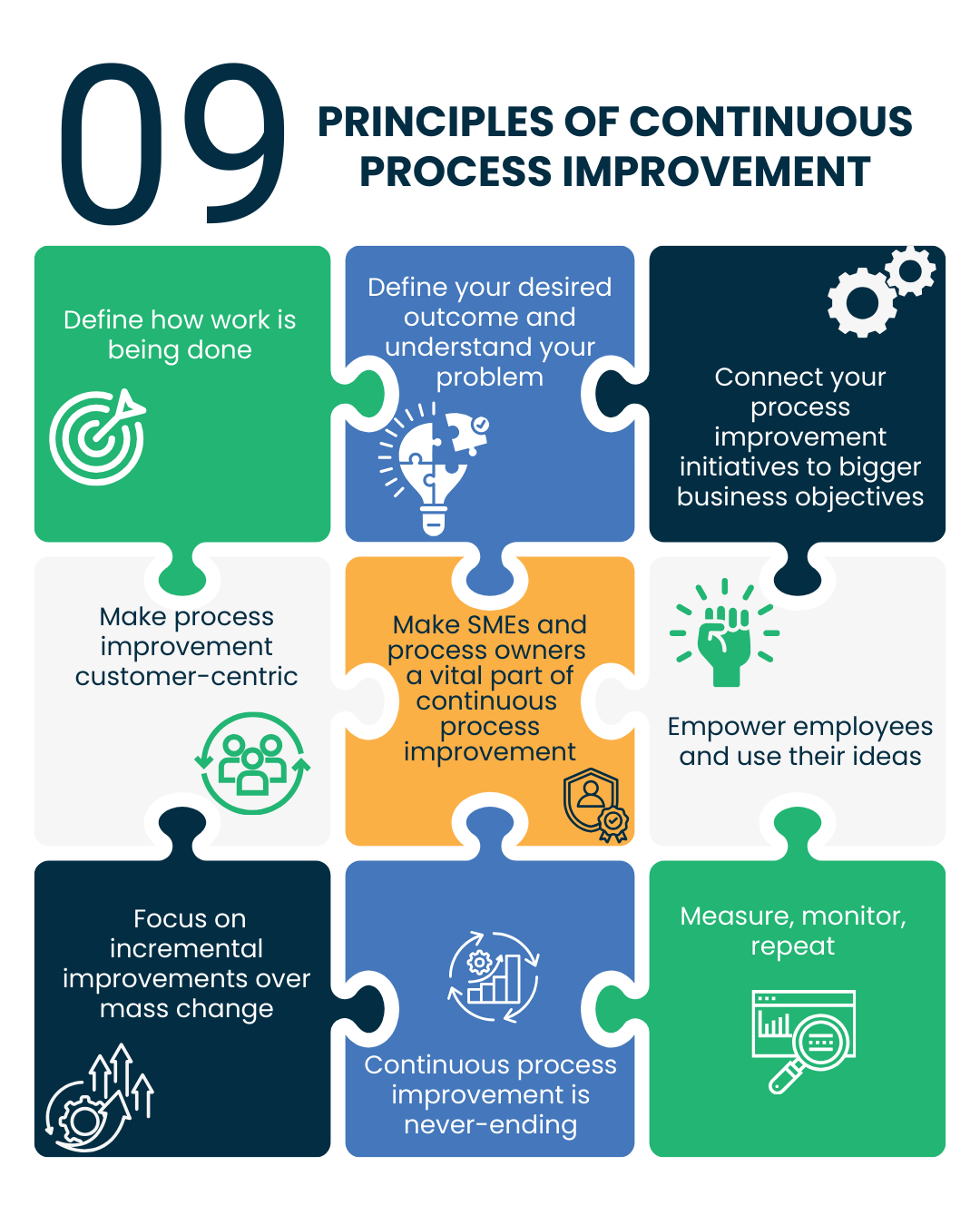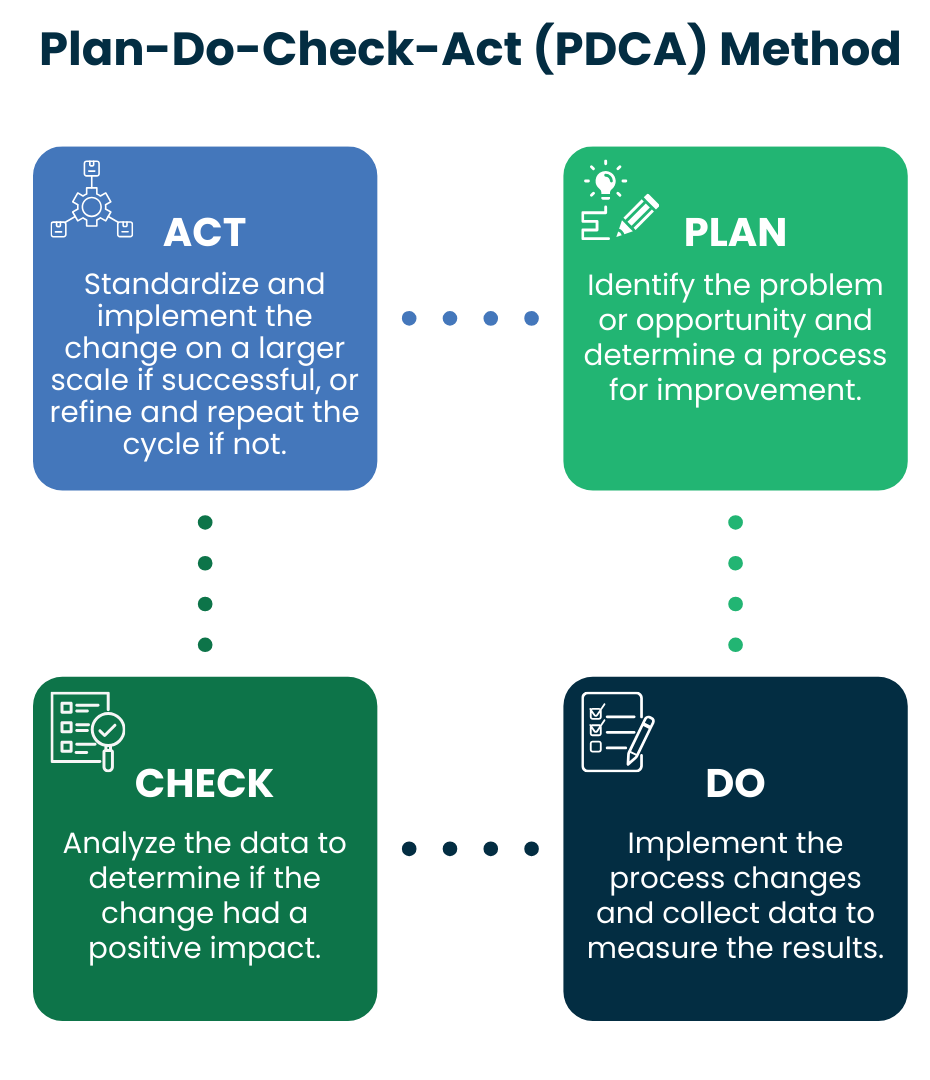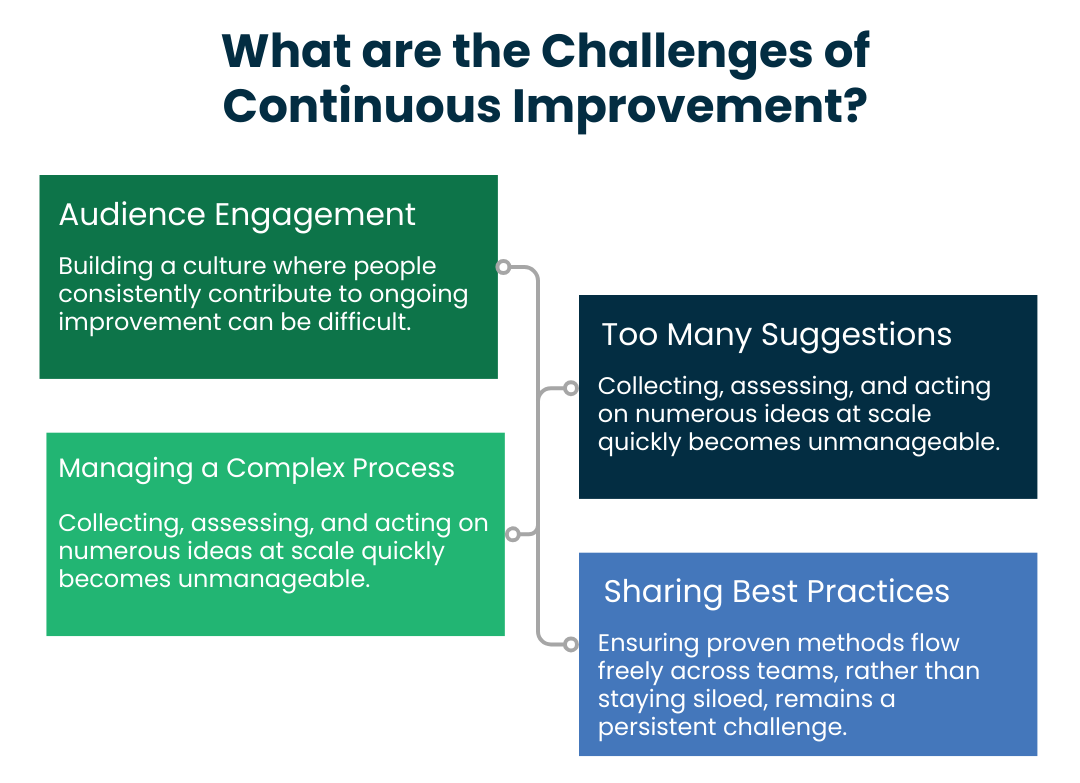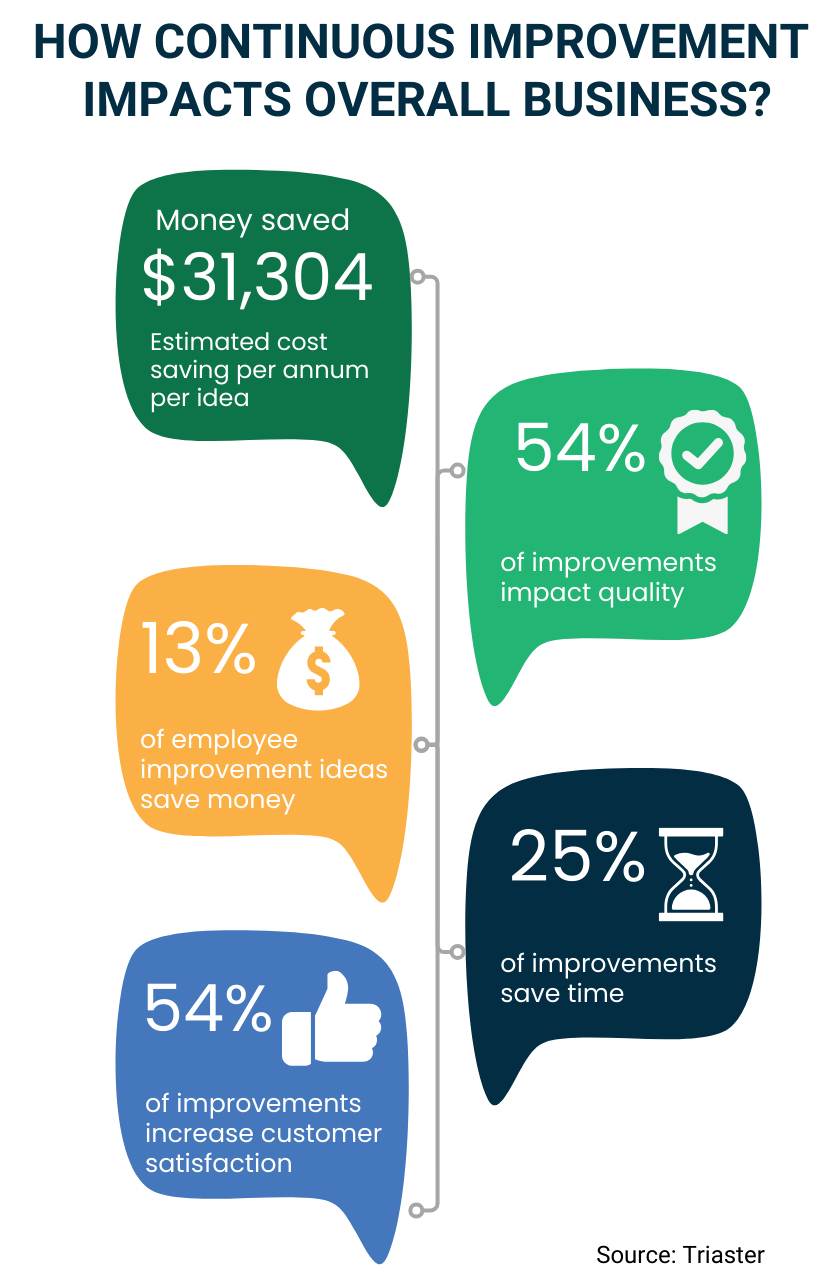
Quick Summary: Continuous improvement in project management transforms projects from static plans into evolving, high-performing systems. When fused with predictive intelligence, teams can spot risks before they surface, act with precision, and deliver measurable, repeatable success.
The case for action is clear: project failures are costing organizations billions. McKinsey reports that large IT projects exceed budgets by ~45% and deliver ~56% less value than promised. PMI finds that 9–11% of investment is lost every year to poor project performance. Against this backdrop, continuous improvement is not a “nice to have” but a survival strategy and a competitive advantage. This article explains why continuous improvement matters, how to embed it across projects, the expected challenges, and how predictive intelligence turns continuous improvement into a durable strategic edge.

Continuous Improvement: The New Baseline for Projects in Constant Flux
What has changed—and why projects demand constant adaptation
Projects today run on shorter cycles with distributed teams and fluid priorities. Customer expectations shift in weeks, not months. Traditional planning frameworks, built on predictability, often break under this volatility.
According to a McKinsey–Oxford study, large IT projects exceed budgets by ~45% and deliver only ~56% of intended benefits. PMI adds that billions of dollars in global project investment are lost each year to cost overruns and underperformance.
These facts make one truth inescapable: continuous improvement is the only way to stay ahead of drift, waste, and unpredictability. Occasional project success is not enough.
Why “post-mortem fixes” no longer cut it
Many PMOs still view improvement as something done after delivery—a retrospective meeting or innovation week. But waiting for end-of-project “lessons learned” delays action and leaves value on the table.
High-performing organizations instead treat continuous improvement as a real-time discipline, embedding feedback, experimentation, and adaptation into every phase of delivery. McKinsey calls this a continuous-improvement culture.
It isn’t about adding meetings. It’s about shortening feedback loops so teams can adjust while the project is still in motion.
If your team still treats improvement as an after-delivery exercise, you may be missing early opportunities. Run a TrueProject SnapShotto surface hidden drift and quality gaps now—before the next crisis.
What is Continuous Improvement in Project Management?
What dimensions must a project-centric continuous improvement program monitor?
Continuous improvement must view each project as a dynamic, interconnected system. Focusing only on schedule or cost overlooks critical leakages. Key dimensions include:
- Quality and defect density
- Rework and scope churn
- Forecast vs. actual variance (schedule and cost)
- Resource bottlenecks and capacity stress
- Risk lead time and recovery effectiveness
- Stakeholder satisfaction and benefit attainment
- Cycle time in decision-making, escalation, and handoff
When one signal drifts, others often follow. Successful continuous improvement interprets these metrics as a holistic early-warning system.
How predictive intelligence embeds foresight into continuous improvement
Traditional continuous improvement waits for events to occur. Predictive intelligence shifts the timeline forward.
- Models forecast schedule or cost drift weeks in advance.
- Alerts come with actionable recommendations—pause non-critical scope, adjust staffing, or add buffer where risk is highest.
- Thresholds adapt dynamically based on observed volatility.
- Cross-project correlations reveal systemic risks (e.g., vendor patterns or repeat design flaws).
- Root-cause analysis accelerates because AI surfaces the most probable drivers.
These capabilities transform continuous improvement from a reactive process into a proactive guidance system. Gartner projects that by 2030, roughly 80% of project-management tasks will be augmented or run by AI. Predictive continuous improvement is no longer optional—it’s becoming the norm.
Imagine every project equipped with an early-warning layer that guides action, not just raises alarms. Book a TrueProject demo and watch prediction convert noise into prioritized insight.
Engineering Continuous Improvement: Frameworks and Pilots That Deliver at Scale

What institutional scaffolding supports continuous improvement at scale?
You cannot rely on individual teams to deliver consistent Continuous Improvementresults. A sustainable approach needs:
- Continuous Improvement Center of Excellence (CoE): Analysts, data scientists, and quality leads define measurement standards, curate predictive models, and evolve playbooks.
- Improvement backlog: Continuous Improvement initiatives are funded, prioritized, and reviewed like any other deliverable.
- Decision gates with signal reviews: Teams present anomaly insights and hypotheses, not just status slides.
- Executive dashboards: Leadership directly connects drift trends and rework savings to strategic KPIs.
This structure ensures continuous improvement is core to delivery rather than a side experiment.

How to pilot continuous improvement + predictive intelligence safely
A prudent pilot balances ambition and risk:
- Select a moderate-complexity project.
- Instrument end-to-end telemetry (task durations, resource hours, defects, change requests, stakeholder sentiment).
- Run predictive models in shadow mode to validate forecasts.
- Calibrate thresholds and surface alerts gradually for decision support.
- Expand to adjacent projects once confidence and measurable gains—such as a 10–20% reduction in drift—are achieved.
- What Scale Looks Like: Predictive Continuous Improvement in a Global Enterprise
A Fortune 100 consumer-electronics company undertook a multi-year digital-commerce transformation spanning five continents. The PMO faced chronic schedule slippage, regional reporting silos, and uneven quality assurance. By establishing a Continuous Improvement Council and running TrueProject’s predictive intelligence in shadow mode across 30 pilot projects, the company uncovered recurring scope-freeze violations and hidden resource conflicts.
Within nine months, it cut average variance by 17% and shortened decision latency by 28%, all without increasing headcount. Leadership attributed success to three practical enablers:
- A central funding model for continuous improvement experiments so regional units weren’t burdened with cost debates.
- A common taxonomy of risks and metrics, allowing predictive models to learn across geographies.
- A governance cadence that blended enterprise reviews with local decision autonomy.
This vignette shows that predictive continuous improvement scales when governance is tight, funding is shared, and model learning is federated—not when every team “does continuous improvement its own way.”
Where Continuous Improvement Falters—and How to Keep It on Track
Where do project continuous improvement initiatives most often derail?
Even with solid intent, continuous improvement programs can falter. Common friction points include:
- Alert fatigue when over-sensitive models flood teams with warnings.
- Process bloat that slows decisions rather than sharpening them.
- Data bias that blinds predictions in new contexts.
- Authority gaps where teams lack mandate to act.
- Change resistance under deadline pressure.
McKinsey notes that ~70% of change programs fail, largely due to behavioral resistance and weak sponsorship. Without strong governance and leadership, continuous improvement can meet the same fate.

How to balance control and adaptability
The answer is calibration. Cap the number of simultaneous experiments. Pilot new practices in canary deployments before broad rollout. Keep human-in-the-loop oversight for high-stakes calls until model reliability is proven. Favor outcome-based metrics over alert volume, and insist on model explainability so teams trust every signal.

Organizational behaviors and change levers
Two silent killers of continuous improvement rarely appear on dashboards:
- Incentive misalignment – when performance reviews reward heroic recovery rather than steady prevention, teams unconsciously prefer firefighting to early intervention.
- Legacy system inertia – fragmented tooling can delay or distort the signals predictive intelligence relies on.
Addressing these requires leadership coaching and structured change frameworks. Kotter’s eight-step model or Prosci’s ADKAR method, for example, can hard-wire urgency, sponsorship, and communication into continuous improvement adoption.
As Deloitte observes, “Culture eats technology for breakfast. Even the smartest predictive system fails if leaders don’t model and reward new behaviors.” Aligning incentives and governance with predictive continuous improvement goals is therefore as important as selecting the right platform.
If your projects face change fatigue or governance gaps, a pragmatic adoption roadmap can mean the difference between success and shelfware. Schedule a Discussion with TrueProject to explore how predictive Continuous Improvement strengthens control while preserving agility.
Proving Impact: Metrics and Benchmarks for Continuous Improvement
- Which key indicators prove that the project's continuous improvement is working?
Measurable evidence is essential. Track variance frequency and magnitude, forecast-to-actual accuracy, defect density and rework effort, decision latency, adoption rate, and continuous improvement ROI.
These metrics resonate with executives because they translate directly into financial discipline, delivery reliability, and stakeholder trust.
- What are realistic performance goals?
Benchmarks vary by industry. Organizations integrating predictive continuous improvement often see 10–20% reductions in schedule or cost drift within the first year. KPMG and Gartner estimate ~15% productivity uplift when predictive analytics are fully embedded in project governance. Over time, internal baselines will become the primary benchmark, with the key being continuous quarter-over-quarter gains.
The Road Ahead: Predictive And Adaptive Continuous Improvement
Where is continuous improvement in project management headed?
Continuous improvement and predictive intelligence are converging. The next frontier is adaptive continuous improvement—systems that not only forecast but also recommend and, for low-risk activities, automatically adjust project parameters.
However, Gartner warns that over 40% of agentic AI projects could be abandoned by 2027 due to weak governance and unclear value. This underscores the need for explainable AI, careful rollout, and ongoing human oversight.
Expanding horizons: AI-driven orchestration and generative planning
Forrester predicts that AI-driven project orchestration—where algorithms dynamically reprioritize backlogs, shift funding, and adjust team composition—will become mainstream within the decade. Coupled with emerging generative-AI planning tools, this could allow continuous improvement cycles to model and stress-test multiple execution paths in seconds, giving leaders far richer decision options.
These innovations will magnify the need for explainable models and strong governance. Predictive intelligence layers such as TrueProject’s can serve as a stabilizing force: learning from each project, maintaining an auditable trail of recommendations, and integrating new data streams without sacrificing trust.
Use case: how predictive continuous improvement works in practice
Consider a global financial-services firm that piloted predictive continuous improvement on a multi-country core-banking upgrade.
The pilot flagged a potential four-week schedule slip six sprints in advance by detecting subtle trends in defect density and resource burn rate. The team reallocated QA capacity and adjusted scope proactively, finishing on time and 8% under budget.
Stakeholder surveys captured through predictive sentiment analysis showed double-digit gains in sponsor confidence. Leadership is now scaling the approach across all transformation programs.
This kind of measurable, proactive adaptation is the hallmark of predictive continuous improvement.
How TrueProject anticipates the next wave
TrueProject is built for exactly this future. Its architecture supports modular, explainable AI, continuous model refinement, and cross-project learning, ensuring that as projects evolve, predictive intelligence keeps pace. This protects your investment and sustains continuous improvement as a living capability.
Future-proof your delivery model before complexity spikes. Schedule a Discussion with TrueProject to explore how adaptive predictive intelligence can safeguard—and extend—your continuous improvement investment.

Conclusion: Continuous Improvement in Project Management, Redefined for Lasting Impact
Continuous improvement in project management is the engine of consistent, high-value delivery. It embeds measurement, analysis, and iteration into every phase, lowering rework, tightening variance, and accelerating decisions. Done well, it transforms projects from isolated efforts into a self-improving capability that compounds advantage across the portfolio.
Beyond efficiency, continuous improvement is a cultural force. It encourages psychological safety—where teams surface issues early without fear—shared accountability, where collective outcomes, and data literacy measure success, where decisions are evidence-driven. Organizations that institutionalize these traits report stronger project ROI and higher employee engagement and customer satisfaction, creating a flywheel of trust and performance.
But discipline alone isn’t enough. To scale and sustain improvement, organizations need predictive intelligence as the guardrail and guide—to see deviations early, prescribe high-impact actions, and refine performance continuously. Without that foresight, improvement remains reactive, and the competitive edge depletes.
This is where TrueProject delivers unique value. Purpose-built as a predictive intelligence layer for project management, it surfaces early risks invisible to traditional dashboards, reads stakeholder sentiment to reveal hidden challenges, and turns live data into forward-looking recommendations. The result is simple and powerful: better decision intelligence, earlier—project after project.
Don’t wait for risk signals to become costly problems. Book your TrueProject demo to experience how predictive intelligence and continuous improvement combine to deliver projects that are not just on time and on budget, but consistently better with every cycle.
FAQs: Continuous Improvement in Project Management
1) What is continuous improvement in project management?
A built-in discipline of measuring performance, diagnosing gaps, and implementing iterative enhancements during the project—not after closure.
2) Why is continuous improvement critical for CIOs, PMO leaders, and CEOs?
It reduces risk and rework, improves forecast accuracy, accelerates decision cycles, and ensures each project strengthens strategic outcomes.
3) How does predictive intelligence enhance continuous improvement?
By forecasting schedule and cost variance early, suggesting corrective actions, and revealing trends—including stakeholder sentiment—that traditional dashboards can’t capture.
4) What metrics confirm that continuous improvement is working?
Track variance frequency and magnitude, forecast-to-actual accuracy, defect and rework reduction, decision latency, adoption rates, and the ROI of continuous improvement initiatives.
5) How quickly can organizations see results from predictive continuous improvement?
Early gains—such as a 10–20% reduction in drift or rework—often appear within the first year of disciplined adoption.






